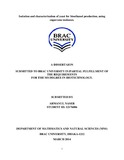| dc.contributor.advisor | Choudhury, Naiyyum | |
| dc.contributor.advisor | Hossain, Mahboob | |
| dc.contributor.author | Naser, Armanul | |
| dc.date.accessioned | 2014-06-18T04:58:20Z | |
| dc.date.available | 2014-06-18T04:58:20Z | |
| dc.date.copyright | 2014 | |
| dc.date.issued | 2014-03 | |
| dc.identifier.other | ID 12176006 | |
| dc.identifier.uri | http://hdl.handle.net/10361/3296 | |
| dc.description | This thesis report is submitted in partial fulfillment of the requirement for the degree of Masters of Science in Biotechnology, 2013. | en_US |
| dc.description | Cataloged from PDF version of thesis report. | |
| dc.description | Includes bibliographical references (page 69-81). | |
| dc.description.abstract | In view of the anticipated shortage of the traditional supplies of fossil fuels there is a great deal of interest in the production of ethanol as an alternative biofuel in recent years. The present study describes the search for potential yeast isolates from various fruit peels capable of producing ethanol. The main objective of this research work was to isolate & characterize stress tolerant, high potential ethanol producing yeast strains from various fruit peel. Two yeast isolates Pa and Or have been characterized on the basis of morphological and physico chemical characters. Based on morphological appearance of vegetative cell under microscope, colony character and physico chemical characters the isolates were identified to be Yeast. Isolates were thermotolerant, pH tolerant, ethanol tolerant as well as osmotolerant. They were resistant to Chloramphenicol (30μg/disc) and nalidixic acid (30μg/disc). The isolates showed no killer toxin activity against E. coli. Ethanol producing capability of the strains were studied using sugarcane molasses as substrate .Ethanol production percentage was estimated by Conway method. The highest bioethanol production capacity of the yeasts were found to be 7.39% and 5.02 for Pa & Or respectively at pH 5.0, 30oC temperature in media with, initial reducing sugar concentration 6.5% for Pa and 5.5% for Or isolate in shaking condition. Addition of metal ions increased the rate of ethanol production highest to 10.61% by KH2PO4. This study revealed that indigenous yeast isolates could be used to benefit the fuel ethanol, spirit and industrial alcohol industries. | en_US |
| dc.description.statementofresponsibility | Armanul Naser | |
| dc.format.extent | 85 pages | |
| dc.language.iso | en | en_US |
| dc.publisher | BRAC University | en_US |
| dc.rights | BRAC University thesis are protected by copyright. They may be viewed from this source for any purpose, but reproduction or distribution in any format is prohibited without written permission. | |
| dc.subject | Biotechnology | |
| dc.title | Isolation and characterization of yeast for bioethanol production, using sugarcane molasses | en_US |
| dc.type | Thesis | en_US |
| dc.contributor.department | Department of Mathematical and Natural Science, BRAC University | |
| dc.description.degree | M. Biotechnology | |

